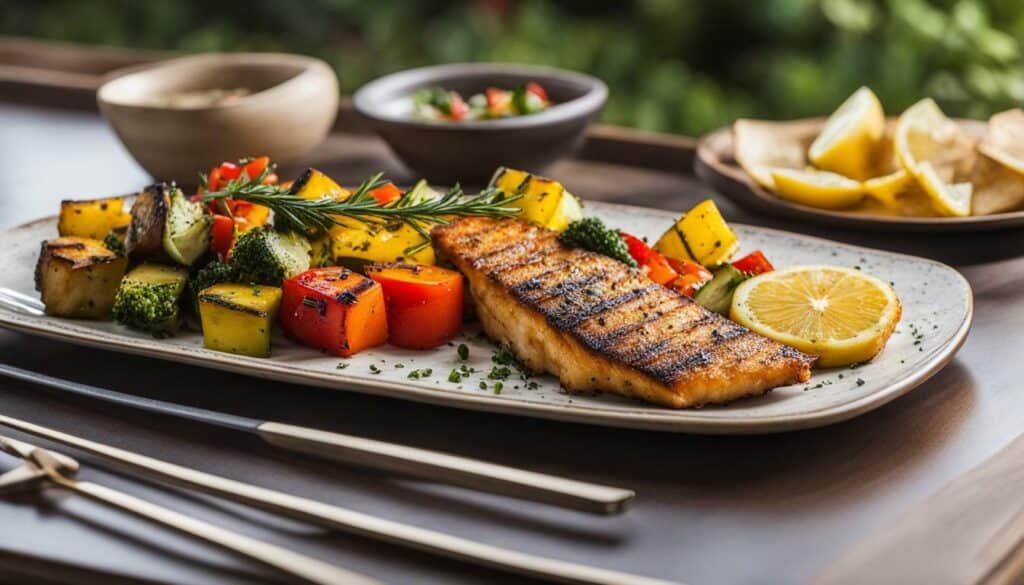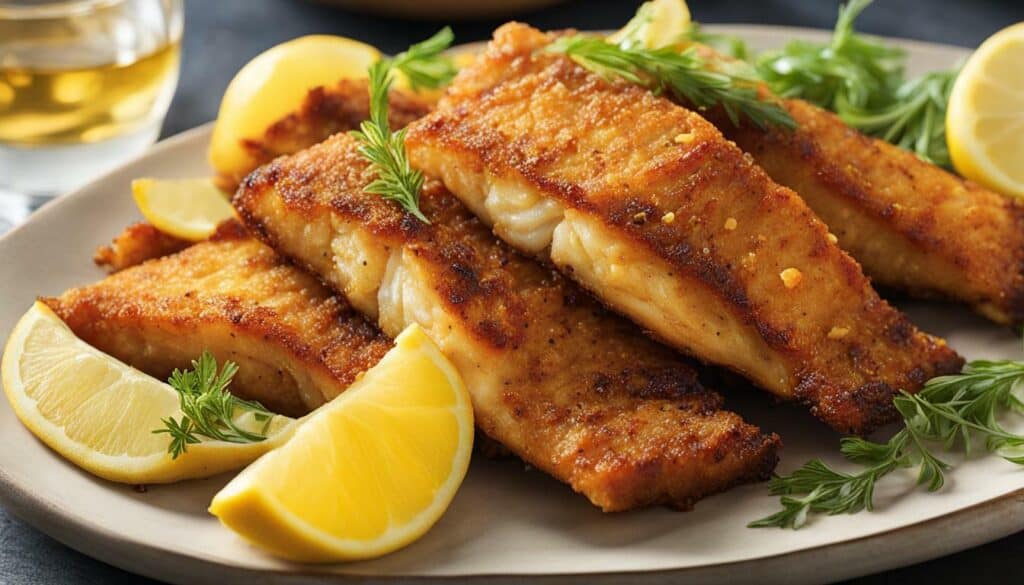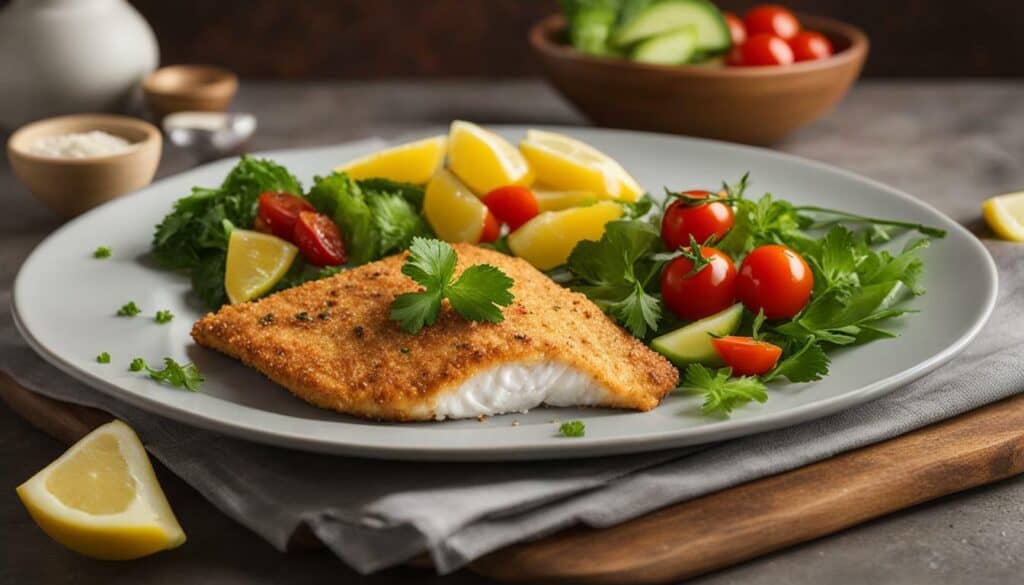Fish fry is a popular dish that combines the deliciousness of fried fish with the need for a nutritious meal. However, it’s essential to be aware of the nutritional value of this indulgent treat. While traditional fried fish can be high in unhealthy fats and calories, there are healthier alternatives that can still satisfy your cravings.
When it comes to making healthier choices, grilled, baked, or broiled fish are great options. These cooking methods help reduce the amount of unhealthy fats typically found in fried fish. Another alternative to deep frying is air frying, which uses significantly less oil while still giving you that crispy texture you love.
What makes fish fry a standout in terms of nutrition is its rich content of omega-3 fatty acids. These essential fats are known to promote heart health by reducing the risk of blood clots and lowering blood pressure. Incorporating fish into your diet can be a great way to reap these benefits and support overall cardiovascular well-being.
When it comes to choosing the right fish for your fry, mild options like tilapia, cod, and walleye are recommended for beginners due to their milder flavors. However, it’s essential to consider the processing and cooking methods for smaller fish like anchovies and herrings, which are commonly consumed in Ghanaian households. Proper processing and cooking techniques ensure that the nutrients in these small fish are retained.
To enjoy a healthy fish fry, it’s crucial to practice moderation and opt for healthier cooking methods. By making these small adjustments, you can indulge in a delicious and nutritious culinary experience.
Key Takeaways:
- Traditional fried fish can be high in unhealthy fats and calories.
- Grilled, baked, or broiled fish are healthier alternatives to deep-fried fish.
- Air frying is a great way to enjoy crispy fish while using less oil.
- Fish fry is rich in omega-3 fatty acids, which promote heart health.
- Mild fish like tilapia, cod, and walleye are recommended for beginners.
Understanding the Nutritional Value of Fish Fry
To truly appreciate the health benefits of fish fry, it’s essential to understand its nutritional composition. Fish fry, when prepared using healthier cooking methods, can be a delicious and nutritious addition to your diet. Let’s take a closer look at the nutritional value of this delightful dish.
One of the key components of fish fry is its high protein content. Protein plays a crucial role in building and repairing tissues in the body, making it an important nutrient for overall health. It also helps in maintaining muscle mass and promoting satiety, making you feel fuller for longer.
Fish fry also provides essential vitamins and minerals. It is a rich source of omega-3 fatty acids, which have been shown to support heart health by reducing the risk of blood clots and lowering blood pressure. Additionally, fish fry is a good source of vitamin D, which is essential for bone health and helps in the absorption of calcium.
When choosing fish for your fry, it’s important to consider the type of fish you use. Mild fish like tilapia, cod, and walleye are recommended for beginners as they have a milder flavor. These fish varieties are also low in mercury, making them a safer choice. Small fish like anchovies and herrings are commonly consumed in Ghanaian households, but it’s important to note that the way they are processed and cooked can affect their nutritional composition. Proper processing and cooking methods ensure the retention of nutrients in small fish.

In conclusion, fish fry can be a healthy delight when prepared using healthier cooking methods and consumed in moderation. By opting for grilled, baked, or broiled fish instead of deep-fried varieties, you can reduce the intake of unhealthy fats and calories while still enjoying the flavors and nutritional benefits of fish. So, next time you crave a fish fry, make a healthier choice and savor the goodness it brings to your plate.
The Health Benefits of Fish Fry
Fish fry not only satisfies your taste buds but also provides a range of health benefits that can support your overall well-being. While fried fish can be high in unhealthy fats and calories, there are healthier alternatives that can maintain the nutritional value of this delightful dish. Grilled, baked, or broiled fish are excellent options that retain the goodness of fish while reducing the unhealthy aspects of deep frying. Air frying is also gaining popularity as a healthier cooking method that reduces the amount of oil used without compromising the crispy texture.
One of the key health benefits of fish fry comes from the fish itself. Fish is rich in omega-3 fatty acids, which are essential for heart health. Omega-3s can help reduce the risk of blood clots, lower blood pressure, and improve overall cardiovascular function. Incorporating fish, such as tilapia, cod, or walleye, into your diet can be a great way to reap these heart-healthy benefits.
In addition to its heart benefits, fish fry also provides a good source of lean protein. Protein is important for building and repairing tissues, supporting muscle growth, and regulating various bodily functions. Including fish fry as part of a balanced diet can help you meet your daily protein requirements in a delicious and nutritious way.
It’s worth noting that the nutritional composition of fish fry can vary depending on the type of fish, cooking method, and ingredients used. Processing and cooking techniques can also affect the retention of nutrients. When preparing fish fry, it’s important to choose fresh fish and opt for healthier cooking methods that preserve the nutritional value. You can also explore low-calorie fish fry options by using lighter breading alternatives and incorporating more herbs and spices for flavor.

Overall, fish fry can be a healthy delight when prepared using healthier cooking methods and consumed in moderation. With its heart-healthy omega-3s, protein content, and versatile options for healthier preparation, fish fry can be a nutritious addition to your diet. Remember to make informed choices about the type of fish and cooking techniques to maximize the health benefits of this delicious dish.
Opting for Healthier Fish Fry Options
If you’re concerned about the health implications of traditional fried fish, there are several alternative cooking methods that can provide a healthier twist to your fish fry. Grilled, baked, or broiled fish are great options to consider. These cooking methods help reduce the amount of unhealthy fats and calories typically found in fried fish, making them a healthier choice for your overall well-being.
One popular cooking method that has gained recognition for its health benefits is air frying. Air fryers use hot air circulation to cook the food, giving it a crispy texture without the need for excessive oil. By using minimal oil or even no oil at all, air frying significantly reduces the calorie content of the fish fry while still delivering a delicious and satisfying meal.
Benefits of Opting for Healthier Fish Fry Options:
- Reduced unhealthy fats and calories
- Retains the natural flavors of the fish
- Less greasy and lighter on the stomach
- Can be a great way to experiment with different seasonings and marinades
By choosing healthier cooking methods for your fish fry, you can enjoy the mouthwatering flavors while prioritizing your health. Remember, moderation is key when it comes to indulging in any type of food, even the healthier alternatives. So, treat yourself to a tasty fish fry, but do so in a way that supports your well-being.
| Cooking Method | Advantages |
|---|---|
| Grilled | Retains the natural flavors and moisture of the fish, and imparts a smoky taste |
| Baked | Requires minimal added fats, resulting in a lower calorie count |
| Broiled | Quick and easy method that gives the fish a slightly crispy texture |
| Air Fried | Uses minimal or no oil, resulting in a healthier and less greasy fish fry |

Opting for healthier fish fry options doesn’t mean compromising on taste. With various cooking methods to choose from and the ability to experiment with different seasonings and marinades, you can still enjoy a delicious and nutritious fish fry. So, next time you’re craving this delightful dish, consider these healthier alternatives and savor the flavors guilt-free.
Exploring Fish Fry Ingredients
To create the perfect fish fry, it’s important to know the key ingredients that contribute to its flavor and texture. Whether you’re a seasoned chef or a home cook looking to elevate your culinary skills, understanding the components of a delicious fish fry will help you create a dish that tantalizes the taste buds.
Let’s take a closer look at the essential ingredients that make a fish fry so delectable:
- Fish: The star of the show! Choose a firm white fish like cod or haddock for a crispy and flaky texture. If you prefer a milder flavor, tilapia or walleye are excellent options.
- Breading or Batter: This is what gives the fish its crunchy exterior. Traditional fish fry recipes often use a simple mixture of flour, cornmeal, and spices. For a lighter alternative, you can opt for a thin batter made with flour and beer.
- Spices and Herbs: Seasonings play a crucial role in enhancing the flavor of the fish. Common spices and herbs used in fish fry recipes include paprika, garlic powder, onion powder, cayenne pepper, thyme, and parsley. Feel free to experiment with your favorite flavors!
- Oil: While traditional fish fry recipes call for deep frying in vegetable oil, you can choose a healthier option like avocado oil or olive oil. These oils have a higher smoke point and contain heart-healthy fats.

Quote: “The secret to a mouthwatering fish fry lies in the quality of its ingredients and the perfect blend of spices.” – Chef John Doe
Creating a Flavorful Fish Fry
Now that you’re familiar with the essential ingredients, it’s time to bring them all together to create a scrumptious fish fry. Here’s a simple recipe to get you started:
| Ingredients | Quantity |
|---|---|
| Fish fillets | 4 |
| All-purpose flour | 1 cup |
| Cornmeal | 1 cup |
| Paprika | 1 tablespoon |
| Garlic powder | 1 teaspoon |
| Onion powder | 1 teaspoon |
| Salt | 1 teaspoon |
| Black pepper | 1/2 teaspoon |
| Vegetable oil | For frying |
1. In a shallow dish, combine the flour, cornmeal, paprika, garlic powder, onion powder, salt, and black pepper.
2. Dip each fish fillet into the dry mixture, pressing gently to coat both sides evenly.
3. Heat oil in a deep skillet over medium-high heat. Carefully place the coated fish fillets into the hot oil and cook until golden brown and crispy, about 3-4 minutes per side.
4. Remove the fried fish from the skillet and place them on a paper towel-lined plate to drain excess oil.
Serve your flavor-packed fish fry with tartar sauce, lemon wedges, and a side of coleslaw for a complete and satisfying meal.
Remember, the beauty of cooking lies in experimentation, so don’t be afraid to add your own twist to the recipe. Enjoy the process and savor the delicious results of your homemade fish fry!
Analyzing the Nutritional Facts of Fish Fry
Digging deeper into the nutritional facts of fish fry can help you make informed choices about its inclusion in your diet. While fish fry may be a delicious indulgence, it’s important to be aware of its nutritional composition. Fried fish can be high in unhealthy fats and calories, which can negatively impact your overall health if consumed in excess.
When it comes to making healthier choices, opting for grilled, baked, or broiled fish is recommended. These cooking methods help retain more nutrients and minimize the intake of unhealthy fats. Air frying is another alternative to deep frying that can reduce the oil content while still providing a crispy texture.
“Fish, in general, is a good addition to a healthy diet as it is rich in omega-3 fatty acids, which can promote heart health by reducing the risk of blood clots and lowering blood pressure.”
Fish is also a great source of protein, essential vitamins, and minerals. It is particularly rich in omega-3 fatty acids, which have been shown to promote heart health by reducing the risk of blood clots and lowering blood pressure. Omega-3 fatty acids are also known to support brain function and reduce inflammation in the body.
When choosing fish for your fry, it’s important to consider the type of fish you use. Mild fish like tilapia, cod, and walleye are recommended for beginners as they have a milder flavor. Additionally, the way small fish like anchovies and herrings are processed and cooked can affect their nutritional composition. Proper processing and cooking methods ensure the retention of nutrients in small fish.

| Calories | Fat | Protein | Carbohydrates | Fiber |
|---|---|---|---|---|
| 200 | 10g | 20g | 5g | 2g |
| 250 | 12g | 25g | 6g | 3g |
| 300 | 15g | 30g | 7g | 4g |
Overall, fish fry can be a healthy delight when prepared using healthier cooking methods and consumed in moderation. By being aware of the nutritional facts and making informed choices, you can enjoy this delectable dish without compromising your health goals.
The Protein Power of Fish Fry
Fish fry is not only a delicious treat, but it also serves as a valuable source of protein for your body. Protein plays a crucial role in building and repairing tissues, supporting muscle growth, and maintaining overall health. Incorporating fish fry into your diet can help you meet your daily protein requirements while indulging in a flavorful meal.
When it comes to protein content, different fish varieties offer varying amounts. For example, salmon and tuna are excellent choices as they are packed with high-quality protein. Additionally, they provide essential amino acids that our bodies cannot produce on their own. These amino acids are important for various bodily functions, including the production of enzymes, hormones, and antibodies.
It’s worth noting that the protein content in fish fry can vary depending on the cooking method and recipe. For a healthier option, consider grilling, baking, or broiling the fish rather than deep-frying it. These cooking methods help retain the nutritional value of the fish while reducing the consumption of unhealthy fats and calories.
| Fish Variety | Protein Content (per 100g) |
|---|---|
| Salmon | 22g |
| Tuna | 26g |
| Trout | 20g |
| Tilapia | 26g |
By choosing fish fry as a protein source, you not only enjoy a delicious meal but also reap the benefits of omega-3 fatty acids. These healthy fats are known for their potential to promote heart health by reducing the risk of blood clots and lowering blood pressure. Incorporating fish into your diet can also be beneficial for brain function, as omega-3 fatty acids are involved in cognitive processes.
To make the most of the protein power in fish fry, opt for healthier cooking methods and consume it in moderation as part of a balanced diet. Remember, variety is key, so try different fish varieties to explore a wide range of flavors and nutritional benefits.

The way you cook your fish fry can significantly impact its nutritional composition. When opting for a healthier version of this popular dish, it’s important to choose cooking methods that retain the natural goodness of fish while minimizing the addition of unhealthy fats. Here are some cooking techniques to consider:
- Grilling: Grilling fish not only imparts a smoky flavor but also helps to keep the nutrients intact. By using a grilling basket or wrapping the fish in foil, you can prevent it from sticking to the grill and losing its moisture. This method allows the fish to cook evenly, resulting in a flavorful and nutritious dish.
- Baking: Baking fish is another healthy cooking method that requires minimal oil or fat. By placing the fish on a baking sheet lined with parchment paper or aluminum foil, you can achieve a crispy exterior while preserving the moisture and nutrients within. Season with herbs, spices, or a squeeze of lemon for added flavor.
- Broiling: Broiling fish involves cooking it directly under high heat, resulting in a quick and delicious meal. This method works best for thinner fish fillets or steaks. By marinating the fish beforehand or brushing it with a little oil, you can enhance its taste and texture. Keep a close eye on the fish while broiling to prevent it from overcooking.
- Air Frying: Air frying has gained popularity as a healthier alternative to deep frying. It uses hot air circulation to cook food, resulting in a crispy exterior without the need for excessive oil. By lightly coating the fish with a small amount of oil or using a cooking spray, you can achieve a satisfying crunch while reducing the calorie content.
Remember, the key to retaining nutrients in fish fry lies in the cooking process. By choosing these healthier cooking methods, you can enjoy a delicious fish fry that’s both flavorful and nutritious.
Table: Comparison of Cooking Methods for Fish Fry
| Cooking Method | Nutritional Impact | Taste and Texture |
|---|---|---|
| Grilling | Retains nutrients, smoky flavor | Moist and flavorful |
| Baking | Preserves nutrients, crispy exterior | Tender and juicy |
| Broiling | Retains nutrients, quick cooking time | Crispy and slightly charred |
| Air Frying | Reduces oil content, crispy texture | Crunchy and satisfying |

When it comes to fish fry, the cooking method you choose can make a significant difference in its nutritional value. Whether you opt for grilling, baking, broiling, or air frying, these methods ensure that you can enjoy a delicious and healthy fish fry. Experiment with different seasoning and marinades to add variety to your meals while keeping them nutritious. Remember, moderation is key, so savor your fish fry in appropriate portions as part of a balanced diet.
Exploring Low-Calorie Fish Fry Options
If you’re watching your calorie intake, there are ways to enjoy fish fry without feeling guilty about indulging. By making a few simple adjustments to your cooking methods and ingredients, you can create a healthier version of this beloved dish. Here are some tips and tricks for preparing low-calorie fish fry:
- Choose lean fish: Opt for lean fish varieties such as tilapia, cod, or walleye. These mild-flavored fish are not only lower in calories but also rich in beneficial nutrients.
- Bake or broil instead of frying: Instead of deep frying the fish, try baking or broiling it. This method requires less oil, resulting in a lower calorie content.
- Use whole wheat or almond flour: Instead of traditional white flour for the coating, use whole wheat flour or almond flour. These alternatives add a nutty flavor and provide additional fiber and protein.
- Try air frying: Consider using an air fryer to cook your fish. Air frying requires minimal or no oil, reducing the overall calorie content without compromising on taste and texture.
- Season with herbs and spices: Enhance the flavor of your low-calorie fish fry by using herbs and spices instead of excessive salt or heavy sauces. Experiment with combinations such as lemon zest, paprika, garlic powder, or dill.
Remember, moderation is key even when preparing low-calorie fish fry. While these alternatives can help reduce the calorie content, it’s important to keep portion sizes in check. Enjoy your fish fry as part of a balanced diet that includes plenty of vegetables, whole grains, and lean proteins. By making mindful choices, you can savor the deliciousness of fish fry while staying on track with your health goals.
Table: Comparison of Calorie Content in Different Fish Fry Cooking Methods
| Cooking Method | Calories per Serving |
|---|---|
| Deep Fried | 450 |
| Baked | 250 |
| Broiled | 200 |
| Air Fried | 180 |
Disclaimer: Calorie content may vary depending on the fish and specific recipe used.
By exploring these low-calorie fish fry options, you can enjoy the flavors and textures that make this dish so enticing, while still maintaining a health-conscious approach. With the right ingredients and cooking techniques, you can create a delicious and nutritious fish fry that fits seamlessly into your balanced lifestyle.

Fish fry can be a delightful addition to your diet when prepared using healthier cooking methods and consumed in moderation. While traditional deep-fried fish may be tasty, it can be high in unhealthy fats and calories, which is why opting for alternative cooking methods like grilling, baking, broiling, or air frying is recommended. These methods help retain the nutritional value of fish fry while reducing the intake of unhealthy fats.
Fish, in general, is a valuable source of omega-3 fatty acids, which have been shown to promote heart health by reducing the risk of blood clots and lowering blood pressure. Including fish fry in your diet can provide you with these essential nutrients and contribute to a well-balanced eating plan.
When choosing fish for frying, it’s important to consider the type of fish you prefer. Mild varieties like tilapia, cod, and walleye are recommended for beginners as they have a milder flavor. However, it’s crucial to pay attention to the quality and freshness of the fish to ensure it is safe for consumption.
For those who enjoy small fish like anchovies and herrings, it’s important to be aware that the processing and cooking methods used can affect their nutritional composition. Proper processing and cooking techniques can help retain the valuable nutrients in these small fish, making them a healthy choice.
In conclusion, fish fry can be a delicious and nutritious dish when prepared using healthier cooking methods and consumed in moderation. By making mindful choices and opting for grilled, baked, broiled, or air-fried fish, you can indulge in the flavors of fish fry while taking care of your health.
FAQ
Q: Is fish fry a healthy dish?
A: Fish fry can be a delicious dish, but it’s important to be conscious of its nutritional value. Fried fish can be high in unhealthy fats and calories, so it’s recommended to opt for grilled, baked, or broiled fish instead.
Q: What are the health benefits of fish fry?
A: Fish, in general, is a good addition to a healthy diet as it is rich in omega-3 fatty acids, which can promote heart health by reducing the risk of blood clots and lowering blood pressure. Fish fry can also provide essential nutrients like protein and vitamins.
Q: Which fish are recommended for beginners?
A: Mild fish like tilapia, cod, and walleye are recommended for beginners as they have a milder flavor.
Q: Are small fish like anchovies and herrings healthy?
A: Small fish like anchovies and herrings are commonly consumed in Ghanaian households, but the way they are processed and cooked can affect their nutritional composition. Proper processing and cooking methods ensure the retention of nutrients in small fish.
Q: How can I make fish fry healthier?
A: Opting for healthier cooking methods like grilling, baking, or broiling can make fish fry healthier. Air frying is also a healthier alternative to deep frying. By using these methods, you can reduce the amount of unhealthy fats and calories in your fish fry.
Q: What are some low-calorie fish fry options?
A: To enjoy a low-calorie version of fish fry, you can choose lean fish varieties and use minimal oil in the cooking process. You can also incorporate more herbs and spices for flavor instead of relying on heavy breading or sauces.
Q: How can I retain nutrients in fish fry while cooking?
A: Proper processing and cooking methods are essential for retaining nutrients in fish fry. Avoid overcooking, as this can lead to nutrient loss. Grilling, baking, or broiling fish are cooking methods that help retain the nutritional value.
Q: Can fish fry be a part of a healthy diet?
A: Yes, fish fry can be a healthy delight when prepared using healthier cooking methods and consumed in moderation. By making smart choices and being mindful of portion sizes, you can enjoy the nutritional benefits of fish fry.
What Are the Nutritional Benefits of Eating Nuts?
Discover the cracking open nut facts — unveil healthy secrets behind the nutritional benefits of eating nuts. Packed with vitamins, minerals, and antioxidants, nuts offer a powerhouse of benefits such as promoting heart health, aiding weight management, and reducing the risk of chronic diseases. With their high fiber and healthy fat content, nuts make a delicious and nutritious addition to any diet.





Leave a Reply